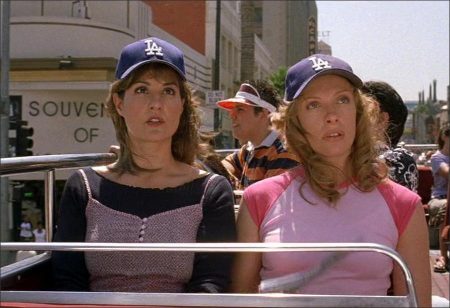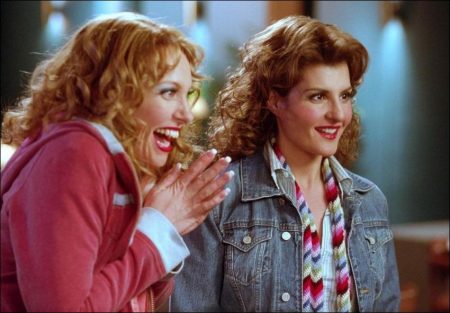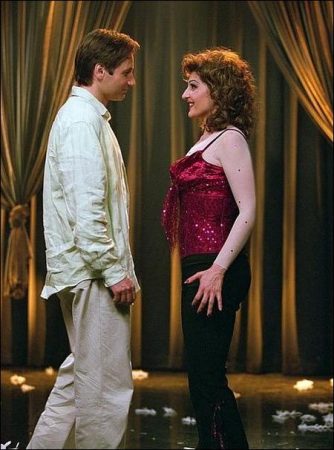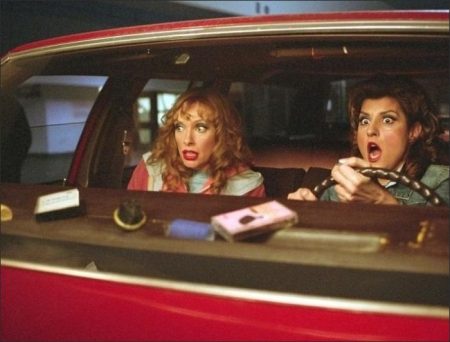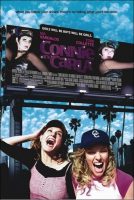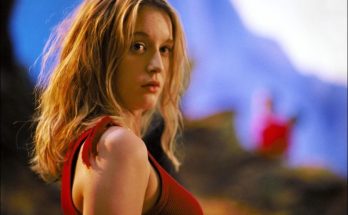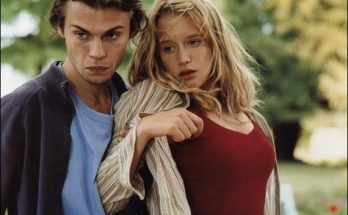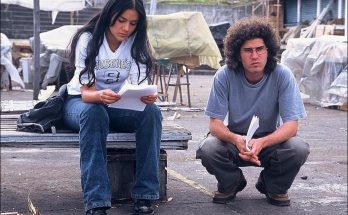Connie and Carla Movie Trailer. Convinced the killers will never look for them in a place utterly devoid of culture (a.k.a. dinner theater), the pair ends up in the Land of Dreamers, Los Angeles. In a new place with new identities, they create a cover (with a lot of cover-up) that makes them the toast of the town — headlining in a local drag club, they soon find the acclaim that has always eluded them, singing the show tunes they’ve always loved. Being famous is their dream come true — who cares if it includes a tiny little lie? — but trying to keep their secret turns out to be a real drag, especially when Connie meets Jeff (David Duchovny), a real nice guy she’d really like to be a real girl with.
Connie and Carla is the comedy that proves if you follow your dream, there’s no telling what you’ll become. Nia Vardalos, the Oscar-nominated writer and star of My Big Fat Greek Wedding, the highest grossing romantic comedy and independent film of all time and the fifth highest grossing film of 2002, follows up that smash hit with the new comedy Connie and Carla, again in double roles as both screenwriter and star (as well as executive-producing). Starring alongside Vardalos is Academy Award and Tony nominee Toni Collette (About a Boy, The Sixth Sense), both of whom are joined by a multifaceted cast that includes Stephen Spinella (Tony winner for Broadway’s Angels in America), Dash Mihok (Baz Luhrmann’s William Shakespeare’s Romeo + Juliet), Alec Mapa (Broadway’s M. Butterfly) and David Duchovny (Evolution, The X Files).
“When My Big Fat Greek Wedding started getting noticed,” Nia Vardalos recalls, “people began knocking on my door asking, ‘What else do you have?’ Of course, I said, ‘Hey, I have this script in my drawer about two women who hide out as drag queens.’”
Turns out that “script in my drawer” was a charmer about two women, starry-eyed dreamers named Connie and Carla, who, through a combination of maintaining a positive outlook in the face of less than glowing reviews and working tirelessly at their craft, finally get their big break in “the biz.” And that is a scenario with which Vardalos is somewhat familiar.
“Oh yeah,” she remembers, “when I started out, my phone wasn’t exactly ringing off the hook with dealmakers looking for that funny Greek girl. Please. But like the classic story, I just kept at it. I really had to be my own cheerleader, at times. It can be really tough, sometimes being the only person in your corner. But I believed. And I worked at whatever I could do. I had yard sales even! And I kept doing what I loved and drawing from my own experiences. I put it all into a play and the right people saw it…and then it happened.”
Producer Jonathan Glickman, President for Spyglass Entertainment, was visiting family in Detroit when Vardalos’ film was playing in theaters. His cousin had just seen My Big Fat Greek Wedding and was crazy about it. Lured by great word of mouth, Glickman watched the movie and liked what he saw.
Glickman recounts, “I’d heard some buzz on the picture—it had made about 10 million at that point, but people hadn’t started talking about Nia… yet. I knew that Peter Safran represented her, so we all sat down and had a very nice meeting. She gave us her script for Connie and Carla and as soon as I read it, I knew there was a great idea in there. I gave the script to Roger [Birnbaum] and Gary [Barber], and we decided to acquire the rights. Then, almost right after that, Nia became a big star.”
When Vardalos was initially writing the script for Connie and Carla, she did not set out to pen a film about drag queens, per se. “I write like I talk,” she says. “I open my mouth and things come out before my brain catches up. My original thinking was that it would be really fun to sing and dance in something, so I started writing about these two girls from Chicago who are dinner theater performers.
They get fired from their jobs, they get evicted from their apartment, then they go to a bar, and finally they think things are looking up because they’re dancing with two guys. And then I wrote ‘and the two guys kiss.’ I mean, what else could go wrong for these two girls? And then I thought, ‘Wait a minute…wouldn’t it be funny if a drag show started and these two girls wanted to be in the show?’ So I went back to the beginning and shifted the concept.”
As she did with My Big Fat Greek Wedding, the performer/writer drew from her own life—and her life-long love affair with musical theater in particular (“Just try and be in a bad mood while singing a show tune…”)—inspiring the titular characters’ own adoration of the genre. While growing up in Canada, Vardalos had performed in musicals while in high school, continuing to sing and dance in summer stock and later in dinner theater. She remembers, “I was performing in Oklahoma at a dinner theater in Toronto—we were waitressing and also in the show, so we would serve them dinner and chat with them and then we’d jump onstage and do the show. At intermission, we’d clear and bring dessert and then finish the show. I thought it was hilarious. I did the show and got to know the audience as I was clearing away their prime rib.”
“Nia’s script is funny and touching,” says producer Roger Birnbaum who, along with Gary Barber, shares the titles of Co-Chairman and Chief Executive Officer of Spyglass Entertainment. “Of all the scripts that come across our desks every single day, this one just really stood out. And when you can break through the clutter with something like this, you go for it.”
Producer Gary Barber continues, “Here was a project that was a great mix of genres—a little comedy, a little romance, some willful mistaken identity, some musical numbers. And at the heart of it all was Nia’s voice, which is a great combination of self-deprecating humor leavened with an enormous amount of heart. It’s never mean-spirited.
It’s a gentle, funny and, at times, raucous comedy, with all that other stuff in the mix as well. And together, it’s all about belief and perseverance and dreams coming true. And did I mention that Nia can really, really sing!”
Incorporating a large array of standards from the milestones of musical theater, Vardalos’ script was truly a labor of love on many levels. She quips, “I just picked every song I’ve ever wanted to sing and wrote it into the movie. Connie and Carla isn’t really a musical, it’s a romantic comedy that has music in it.”
Vardalos continues, “I believe that with comedy you make the audience laugh, but you also need to give them moments of poignancy, time to rest, absorb, before you hit them with the next laugh. In those moments of rest, you can actually slip in a message without hitting them over the head. I think the message here is really about acceptance of the other. It’s about love, love of those that are a little different. We’re all different and that’s okay. Like with my family—they roast a lamb in the front yard…whatever!”
Because of its eclectic mix of genres, along with the music, choreography and elaborate costume, makeup and hair requirements, Connie and Carla needed a deft hand to bring it to the screen. “As fun as this script was to read, it was also a little bit difficult to visualize and we knew it was going to be a production that offered some challenges,” explains Birnbaum.
“I think the most important thing was getting a director who could capture the feel of the music, along with the comic elements. And I think we found the perfect person in Michael Lembeck,” offers Barber. “Once he was hired the project really came to life. It was amazing. Michael pulled together the best music people for the recording sessions, in which all the instrumental and vocal tracks were laid down prior to filming. Once that was done, Michael and Nia steered the process and the movie really took on a life of its own.”
“When I first read the script, Connie and Carla appealed to my entire history, theatrically speaking,” explains director Michael Lembeck. “My Dad did many Broadway shows and from the time I was seven-years-old, he started taking me to the theater. Also, as an actor, I’ve performed in dozens of musicals. It’s something I’ve always loved to do and loved to go and see. But perhaps more importantly, it was the story itself that appealed to me…the idea that you don’t have to compromise to realize your dreams. People compromise who they are all of the time in order to achieve some form of success or to reach a certain goal. This movie says that you don’t have to. You can be who you are and still get to that same place.”
Lembeck had worked with Vardalos when she had played a small role on the television series Two Guys and a Girl, which Lembeck directed. “He was so nice to me,” says Vardalos of that earlier encounter, “that when his name came up for directing this movie, I was thrilled to sit down with him. Then, of course, I found out he was a big musical theater geek! My favorite thing about doing the big dance numbers in the film has been looking out by the camera and seeing Michael doing the dance numbers along with us.”
Something else that provided Lembeck with a cause to celebrate was the skillful musical performances from his two leading ladies. He offers, “Whenever you have established stars doing something new, something most of their fans haven’t seen, there is a moment in a theater when the audience holds it breath—like a comic actor in a Shakespearean role, for example. Well, I knew that both Nia and Toni were powerhouse singers, but I don’t think their fans know it. I can’t wait for that moment when the world hears, like I have, these women opening their mouths and these amazing voices just pouring out.”
Vardalos and Lembeck worked together to refine the script before shooting began, and continued the process throughout filming. “As a writer, Nia is the most affable, joyous person I’ve ever collaborated with. She’s so much fun. She’s so receptive to ideas. She’s unafraid to say, ‘No,’ and she’s unafraid to say, ‘Yes,’” Lembeck enthuses. “As an actress, it’s been wonderful to look into her eyes, give her adjustments and then watch her just get it, and then to deliver it even better than I heard it in my head.”
Vardalos practically had to beg actors to work on My Big Fat Greek Wedding. High on Vardalos’ wish list this time around was to have Toni Collette take on the role of Carla. “I just love her,” says Vardalos. “Every actress I know wants to work with her because she’s a broad, you know, not too girly, not too tough. She’s just this great woman.”
Glickman immediately saw the brilliance in Vardalos’ desire to have Collette as her co-star. “We knew we needed somebody who could sing but who wasn’t such a gigantic celebrity that it would break up the reality of the movie,” Glickman recalls.
“The great thing about Nia is, people in this country accept her as an everyday woman, and we didn’t want somebody opposite her who was going to infringe on that belief and bring a feeling of ‘now, we’re in a slick Hollywood movie.’ Toni is a tremendous actor who becomes immersed in the character. I think she is one of the best actors working in film today. Plus she’s a tremendous singer and dancer.”
The filmmakers were thrilled when Collette read the script, loved it and signed on to do the project. Connie and Carla proved to be a bit of a trip down memory lane for Collette, taking her back to her earliest theatrical roots. Collette recalls, “During high school, I was encouraged to audition for a musical that was being put on by the Australian Theater for Young People. I did that show and several others with the troupe. It was all singing and dancing—hammy, cheesy stuff—and for a long time, I really didn’t want to return to musical theater. This film has allowed me to fall in love with it again.”
There was also consensus that David Duchovny was absolutely right for the role of Jeff, Connie’s love interest and estranged brother to Robert, one of the performers at the club. “Nia and David had a genuine, wonderful chemistry together,” Lembeck recalls. “David is a warm, funny, beguiling guy with a bawdy sense of humor. This role gives him license to exhibit some of those qualities.”
“I’m the straight guy in the picture,” says Duchovny. “Not necessarily un-funny, but literally, the straight guy. The biggest challenge was portraying Jeff as naïve enough that he wouldn’t peg Connie as a woman, but still intelligent enough so that people could say, ‘Yeah, he’s smart, and yet he’s fooled by this.’ What I really like about the relationship between Jeff and Connie is that it makes sense that he would be able to speak to her man-to-man. It’s kind of Shakespearean in that way—a man falling in love with a woman who’s playing a man.”
“It reminds me of As You Like It,” agrees Stephen Spinella, who plays Robert, Jeff’s long-lost brother. “Orlando falls in love with Rosalind, who’s dressed as a boy, and she teaches him about the true nature of love—much like Robert and Connie teach Jeff, through their interaction, that love is about acceptance. My biggest challenge was discovering the size of the character. He’s someone outside of the mainstream, wildly flamboyant and yet completely human. Robert has these very subtle scenes with Jeff which are deeply painful and honest…and he also has to be completely fabulous.”
(In one scene of Connie and Carla, it is actually explained that the word “drag” may have originated from stage directions in Shakespeare’s plays; when an actor was needed to enter “dressed as a girl,” men playing women’s roles being the custom of the age, the note “d.r.a.g.” was written in the margin.)
Spinella is a consummate stage actor, a two-time Tony Award winner for his work in both parts of Tony Kushner’s seminal Angels in America: Millennium Approaches and Perestroika.
“Stephen came to us with an enormous amount of acting chops,” says Glickman. “He had never done anything this ‘out there’ but came to it with such a natural sense of himself that it helped us to buy the conceit of the story.”
Dash Mihok was cast as Mikey, Carla’s boyfriend who, while supportive of his girlfriend and her dream, would much prefer her closer to home. Mihok, like Lembeck, had been raised in a musical theater family and was drawn to the project by Vardalos’ script and the opportunity to work with the ensemble and director Lembeck…and for one scene in particular. Mihok discloses, “There’s a point where Mikey tracks down Carla, and can’t really understand the direction her life has taken. So he gets drunk and sings ‘Memory’ from Cats alone in a park at night. You don’t get to do that every day, now, do you?”
Theatrical chameleon Alec Mapa (cast as club performer Lee, stage partner to Robert) was likewise attracted by the script and had to overcome some initial reservation about auditioning for the role. Having made a name for himself performing as the enigmatic, cross-dressing character at the center of the Broadway hit M. Butterfly, Mapa recalls he “needed to do another drag role like I needed another hole in my head. But Nia imbues her writing with such warmth and humanity, and I discovered that the script was about finding your place in the universe and pursuing your dreams… much larger issues than running around a stage in a dress and heels.”
In keeping with the “wish fulfillment” side of the script, Vardalos wrote a cameo role for Debbie Reynolds. The legendary star of countless films and musicals who had also danced and sang her way across nightclub stages, casino showrooms and concert halls worldwide was the perfect icon for two singer/dancers with big dreams. “I never thought we’d get her,” offers Vardalos. “I thought we’d end up casting one of my aunts in the role. I truly had a Field Of Dreams moment when Debbie showed up on set, because it was like, ‘If you build it, she will come.’ I wrote it…and there she was!”
Reynolds was a huge hit on the set, whether perched on the grand piano belting out a tune or regaling the cast and crew with a racy stand-up comedy routine during a lighting turn-around. “It seems that these two girls have always loved musicals,” Reynolds muses. “And of course, along with that comes all the old-time movie stars and being that I was probably the only one still alive, Roger thought of me. Actually, I’ve known Roger since he was about 11, he ran around with my daughter at school. He called me up and asked me to do it. I read the script and thought it was crazy, a bit offcenter… and I like off-center. I think it’s a little spoofy and a little campy and we could do with a comedy like this right now.”
“Debbie to me has always been one of my best friends’ moms. She and I have known each other for a long time,” adds Birnbaum. “When I first met her, she sang ‘Tammy,’ and as a little boy, I think she broke my heart singing that song. The fact that I’m making a movie today and she’s singing in it, is just a perfect circle for me.”
The cast was rounded out with a myriad of performers from stage, motion pictures and television: Chris Logan and Robert Kaiser as Brian and Paul, two club performers who also join the girls’ act; Nick Sandow as Al, Connie’s boyfriend who inadvertently leads the mob to the girls at the club; Boris McGiver as mob henchman Tibor, who develops a keen appreciation of dinner theater while searching for the witnesses on the lam; and Robert John Burke as Rudy, the mob boss out to eliminate Connie and Carla…if he can just find them.
The long-time comic device of characters pretending to be something else not only dovetails perfectly with the film’s conceit of Connie and Carla impersonating female impersonators, but also provides an unexpected setting for the heart of the film and its message about self-acceptance. Connie and Carla disguise themselves as men, only to find that they become more deeply and profoundly in touch with their femininity. Their more flamboyant drag personas allow their talent to shine, while providing them with an opportunity to sound off (with perhaps a stronger voice than their own) about such topics as body issues, the beauty industry and about what constitutes an honest and quality relationship between two people. However, trying to suppress their own femininity while adding a false layer of exaggerated male “femininity”—an idealized version of what a man thinks it is to act like a woman—left the actresses just wanting to be girls again.
“When we were doing four weeks of shooting as drag queens every day, I missed being a girl,” says Vardalos. “I was tired of wearing heavy makeup and these gigantic wigs that I called fur hats.”
“It’s almost like the way people talk about acting—putting on a hat, becoming a character,” adds Collette. “That’s kind of what Connie and Carla do. They pose as somebody else and somehow, that posture helps them realize the positive parts of themselves. These girls are so beautiful, in part because of their naïveté—that’s the thing that actually gets them through their entire plight. Anybody else faced with the same circumstances would just give up. But they’re able to look on the bright side of everything, land on their feet and not let go of this almighty dream they have.”
Creating a believable world for Connie and Carla to inhabit turned out to be both a challenge and a delight for the talented production team that includes Oscar®- nominated cinematographer Richard Greatrex, two-time Academy Award®-nominated costume designer Ruth Myers and production designer Jasna Stefanovic.
Much of the action of the film takes place in the club where Connie and Carla perform. “We didn’t want Connie and Carla to be a slick Hollywood version of the world of drag queens,” says production designer Stefanovic. “What we found through our research is that real drag clubs tend to be unglamorous places themselves that become glamorous partly through lighting, but mainly from the drag queens’ personalities. As a designer, my first instinct is to make things beautiful, but in this case I had to make the place look drab and somewhat unattractive. I opted for low ceilings, worn comfy seating and layers of paint to create a patina of age.”
“On that glorious day when they picked me to direct this movie, I immediately immersed myself in drag culture,” Lembeck recalls. “I went to all the clubs. I wanted to know what the clubs look like, why the drag queens wear what they wear, what their makeup looks like, how they think, what makes them tick as performers and what their interaction with the audience is like.”
“One of the key elements of this movie for me has been working with the notion of disguises,” comments costume designer Myers. “It’s been fascinating to take a peek into the world of drag queens. I felt a lot of warmth and kindness in the clubs and I’ve been very eager to get that on the screen. I wanted to portray the ready emotion and the strength I saw there—the beauty and the extravagance. I also wanted to treat these characters with honesty and dignity and not go too over-the-top. So dressing the girls and the boys has been challenging because it has to work on many levels.”
Director of photography Greatrex also felt that his key challenge with lighting was to help the audience buy the conceit of the two women posing as men. “I constantly had to work with their ‘masculinity’ without denying their femininity and that’s the trick in the lighting,” says Greatrex. “Because of the human scale of the story, I tried to keep the lighting as realistic as possible.”
In the course of their characters’ on-screen arc to stardom, Vardalos and Collette have in excess of 40 hair, makeup and costume changes throughout the movie. “When I came up with the idea of these women disguising themselves as drag queens, never in my wildest dreams did I realize what it would actually entail—like three hours of makeup and hair everyday,” Vardalos remembers. “Then came the corsets, and then they’d sew us into our costumes because everything’s got to be tight. You’ve got to feel like you’re exploding out of it for it to ‘fit’! On the weekends, I’d just lie on the couch in a loose cotton shift like a gelatinous blob,” she laughingly adds.
“One of the most important dynamics within the crew was the very synergistic relationship between production design, hair, makeup, costume and lighting design,” interjects Lembeck. “Every one of these had to work in tandem with all of the others because they all change together. They all experience a qualitative heightening as the movie progresses.”
“I’m dead and gone to heaven,” observes makeup artist Charles Porlier, who headed up the makeup department with Connie Parker. “The hundred different colors, sizes and shapes of glitter and the eyelashes made of dyed chicken feathers are a lot of fun, but the challenge comes in changing two lovely ladies into two lovely men and selling these ‘men’ not only to the audience, but to the characters in the film as well. We had a number of very distinct problems because in a drag makeup, you’re adding things that are traditionally identified with femininity, things like big eyelashes and lots of makeup. Ultimately, these things tend to feminize your subject. So, we had to take two women, put all that feminizing accoutrement on their faces and then figure out a way to fool everybody into believing that they’re men. We ended up doing very aggressive work in shading jaw lines, highlighting and shading jaws and noses and squaring off lip lines, all of which nudge us in the direction of fooling the eye. It’s a very subtle trickery.”
“We designed close to 150 wigs for this show,” says hair stylist Donna Bis, who ran the department with Pauline Tremblay. “Every one of the wigs for this show is different and has to work with very stylized costumes and makeup, particularly for the musical numbers.”
Also to be considered was the evolution from the neophyte drag that Connie and Carla initially affect to a more refined look as time progresses and they learn the tricks of the trade within their newfound milieu. “In effect, the girls’ look had to become more and more beautiful and glamorous while still remaining male in character,” Parker notes.
Lembeck assembled an all-star team to enhance his own extensive musical theater background and put the “song and dance” into Connie and Carla. Musical director Paul Bogaev (a musical theater veteran who served as music supervisor on the Oscar® winner Chicago) tailored the arrangements of classic Broadway show tunes to reflect the momentum of the story. “The similarity between the work required here and the work I did for Chicago is that both films use show music and show music, or theatrical music, has to be acted in order for it to be effective.”
Bogaev worked extensively with the cast in singing rehearsals, tackling the challenge of making Vardalos and Collette sound more masculine by dropping the keys and working on lowering their “chest” voices. The cast then recorded their vocals to the instrumental tracks Bogaev created and the resulting tracks were utilized as playback (for the cast to sing live to) during filming.
As Connie and Carla’s journey progresses and they change and grow, the music undergoes a transformation as well. “Our sound starts out with a spinet piano that is supposed to sound like Connie’s mother is playing it—a kind of ‘thump along and play the notes as they’re written’ sound,” Bogaev continues. “We then progress to a grand piano and then later, we add drums and guitar, as their act draws an ever larger audience and the club begins to prosper.” The songs themselves and the arrangements and production numbers likewise grow in complexity and sophistication—with selections from Oklahoma, Cabaret, Funny Girl and Gypsy, to name a few.
Yet another item on the pre-production agenda was choreography. “The joke in my family is that I dance like a Muppet,” says Vardalos. “Suddenly I found myself in dance rehearsals and dancing isn’t something you can fake, so I just practiced and practiced.”
Cynthia Onrubia, who served as associate choreographer and Richard Gere’s tap choreographer on Chicago, created the film’s choreography and continued to work with the cast throughout filming. The dancer/choreographer’s impressive Broadway musical career began at age 15 when she became the youngest member of the Broadway cast of A Chorus Line.
“In theater, you generally rehearse for six weeks, tech for three-and-a-half weeks, then you go into previews for three-and-a-half weeks, then you open and the show is locked,” offers Onrubia. “We only had two weeks of dance rehearsal prior to shooting and then mini-rehearsals for each new number as it presented. It was fast. But everyone worked above and beyond and I think did a fabulous job.”
The Girl Next Door (2004)
Directed by: Luke Greenfield
Starring: Emile Hirsch, Elisha Cuthbert, Timothy Olyphant, James Remar, Christopher George Marquette, Timothy Bottoms, Amanda Swisten, Olivia Wilde, Donna Bullock
Screenplay by: Brent Goldberg, Stuart Blumberg, David Wagner
Production Design by: Stephen J. Lineweaver
Cinematography by: Jamie Anderson
Film Editing by: Mark Livolsi
Costume Design by: Marilyn Vance
Set Decoration by: Traci Kirshbaum
Art Direction by: Jason Weil
MPAA Rating: R for strong sexual content, language and some drug / alcohol use.
Distributed by: 20th Century Fox
Release Date: April 9, 2004
Views: 169
